![]()
![]()
![]()
Use LEFT and RIGHT arrow keys to navigate between flashcards;
Use UP and DOWN arrow keys to flip the card;
H to show hint;
A reads text to speech;
97 Cards in this Set
- Front
- Back
- 3rd side (hint)
|
Afferent |
(Admit) brings info into structure (ex. presynaptic) |
pg. 2 of power point |
|
|
Efferent |
(Exit) takes info away from structure (ex. postsynaptic) |
pg 2 |
|
|
Interneuron |
axon and dendrites all within single structure (ex. within thalamus, or hippocampus) |
pg 2 |
|
|
Purkinje Cell |
(in cerebellum) -Many dendrites -intergrates info from many cells |
3 |
|
|
Cerebellum |
(fine motor skills) -takes in a lot of info. |
|
|
|
Bipolar Cell |
(retina) -few dendrites (with detailed info) -intergrates info from small number of cells |
|
|
|
Glia Cells |
Don't move |
|
|
|
Astrocytes |
(G.C.) -exchange chemicals that help synchronize axon activity -remove waster materials. (ex. neural death) -regulates blood flow |
|
|
|
Oligodendrocyte |
(G.C.) -builds myelin |
|
|
|
Microglia |
(G.C.) removes: -waste -viruses -fungi |
|
|
|
Radial Glia |
(G.C.) -progenitor cells -makes new and moves neurons and glia -aids in axon, dendrite growth |
|
|
|
Blood-Brain Barrier make-up |
endothelial cells tightly packed (little can pass) |
|
|
|
Blood-Brain Barrier- what passes, passively? |
oxygen carbon dioxide water molecules that dissolve in fat membrane (ex. drugs, vitamins) |
|
|
|
Blood-Brain Barrier - What passes actively? |
(requires energy) glucose amino acids |
|
|
|
Importance of glucose? |
-neurons depend mostly on glucose and oxygen -main nutrients that cross B-B-Barrier |
|
|
|
What effects glucose passing through B-B-Barrier? and why? |
Thiamine deficit -Thiamine is critical for glucose use -Can lead to Korsakoff's Syndrome |
|
|
|
Korsakoff's Syndrome |
-difficulty forming conscious memories -caused by alcoholism |
|
|
|
Korsakoff's Syndrome can lead to what? |
emtarigrade amnesia - unable to form conscious memories |
|
|
|
Warrington & Weiskrantz (1970) |
Performed memory tests on control group and emtarigrade amnesics. Test performed - 50 pictures/words are studied and then asked to recall them along with 50 new pictures/words and telling whether it is a new set or not. Results - Control 75% and E. Amnesics 40% Concluded - Emtarigrade amnesics had intact implicity memory and malfunctioning explicity memory. |
|
|
|
What implicit and explicit memory? |
implicit is memory that is unconsciously learned (exposed to a word and then using it later) explicit is consciously learned. |
|
|
|
What is the test for implicit memory? |
Have amnesic group be passively exposed to words then in testing later group is given incomplete words and are asked to fill in the words. results are that they will be filled with words exposed to earlier. ex. exposed to the word elephant test: e_e_p_a_t given answer - elephant |
|
|
|
Resting Potential |
more negative ions inside cell than outside of cell (at the ready to be fired-polarized) Has charge of -70 millvolts |
|
|
|
What charge does a neuron have the resting potential ready? |
negative charged (ex. -70 mv) |
|
|
|
What does the make up of the cell look like (4 elements) |
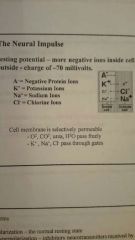
|
|
|
|
What does the cell membrane allow to pass freely? |
(neural impulse - resting potential) -Oxygen -Carbon Dioxide -Water |
|
|
|
What does the cell membrane allow to pass through gates? |
(neural impulse- resting potential) -Pottasium -Sodium -Chlorine |
|
|
|
Polarization |
the normal resting state (charged) |
|
|
|
Hyperpolarization |
inhibitory neurotransmitters received by dendrites -membrane is less permeable (accessible) to Sodium (Na+) |
|
|
|
Action Potential |
the electrical charges occurring when the neuron fires |
|
|
|
Steps of Action Potential |
1. Dendrites receive excitatory neurotransmitters 2. Sodium gates open - depolarization (opens gate and fires- shot thrown) 3. Neurotransmitters released from teriminal buttons (exit neuron) |
|
|
|
Absolute Refractory Period |
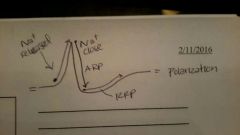
Immediately after firing 1. Sodium (Na+) gates close 2. Potassium (K+) gates open - to return to resting potential |
|
|
|
Sodium-Potassium Pump |
pumps Na+ OUT and K+ IN *if neuron fires repeatedly, Na+ will build up. Excessive build up is toxic. |
|
|
|
Relative Refactory Period |
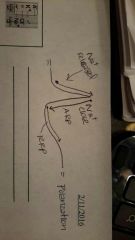
After the absolute refactory period * Can fire, but wokd require more energy since it's not fully polarized yet. |
|
|
|
Myelin does what for neuron? |
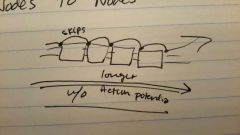
increases speed of transmission by allowing impulse to skip down axon from node to node |
|
|
|
Saltatory Conduction |
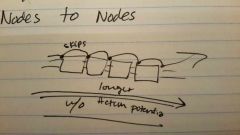
Action potential (AP) skips across nodes of Ranvier |
|
|
|
Local Neurons |
-short axon -exchange info with close neighbors only -do not produce AP -produce graded potentials (vary in magnitude) (depolarizes or hyperpolarizes in direct proportion to the intensity of input) |
|
|
|
Horizontal Cell is an example of what kind of neuron? |
Local neurons |
|
|
|
What are graded potentials? |
Vary in magnitude - depolarizes or hyperpolarizes in direct proportion to the intensity of input. |
|
|
|
Why is traveling the axon faster than traveling synapses? |
Synapes are slower because chemical communication is required. |
|
|
|
What is the Synapse? |
-The space between terminal buttons of efferent neurons and dendrites of afferent neuron. (Neurotransmitters are released by efferent neuron into synapse and received via the dendrites of afferent neuron. |
|
|
|
Who discovered the synapse? |
discovered by Cajal in later 1800s |
|
|
|
What did Sherringtons (1906) study and what were the results? |
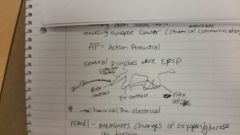
Studied reflex arc of dogs by pinching a dogs foot. Observed: 1. Timing was slow (slow due to traveling through synapses) 2. Temporal summation 3. Spatial Summation 4. Whenof set of muscles is excited, another set it relaxed. -one light pinch did not reach threshold of AP -several light pinches did reach AP |
|
|
|
Excitatory PostSynaptic Potential graded depolarization (EPSP) |
multiple ESPS that are summed to lead to AP example: multiple light dog pinches caused eventual reflex. |
|
|
|
Due to inhibitory synapses what happens to dogs reflexes? |
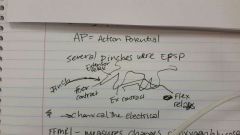
interneuron send excitatory signals to certain muscles and inhibitory signals to others. result: dogs extensor and opposite foot flex would relax and the flexor (pinched area) and opposite foot extensor would contract (reflex) |
|
|
|
Inhibitory PostSynaptic Potential (IPSP) polarization |
When AP caused by summed EPSP and caused opposite muscle groups to be inhibited (relax) |
|
|
|
Spontaneous Firing Rate |
Occasional (random) firing of neuron. -expirements will compare spontaneous firing rate to firing rate in specific conditions. |
|
|
|
With ESPS and ISPS, which increased firing rate and which decreases firing rate? |
ESPS - increased firing rate ISPS - decreased firing rate |
|
|
|
What is a neuron? |
aka decision maker when activation exceeds a specific level, it makes a response (ex. fires) -like a smoke detector -a complex decision will not rely on a single neuron. |
|
|
|
What did Sherrington hypothesize about transmission? |
That it was entirely electrical transmission of neurons |
|
|
|
Elliott (1905) studied what and summized what? |
studied: applied adrenaline (chemical) to the heart, stomach, pupils. and this stimulated muscles.
Concluded: that sympathetic nerves stimulate muscles via adrenaline or similar chemical Summizing that transmission of neurons is not entirely electrical, but also chemical. |
|
|
|
Loewi (1920) studied and summized what? |
STUDIED: -stimulated vagus nerve of frog (decrease heart rate) -then collected chemical -Put collected chemical on 2nd frog's heart and decreased HR 1950s: established that chemical transmission is the main type on communication |
|
|
|
Summary of Events at the Synapse (List 5) |
1. Neuron makes neurotransmitters (NT) 2. AP travels down axon 3. NTs attach to receptors in postsynaptic neuron 4.NTs sperate from receptors 5. Postsynaptic cells release chemicals that slow further release of NTs in presynaptic neuron. |
|
|
|
Where are small NTs and large NTs made? |
Small NTs - made in terminal buttons Large NTs - (ex. peptides) made in cell body then transported to terminal buttons |
|
|
|
What happens when the AP travels down the axon? |
-enables calcium to enter terminal -calcium releases NTs into synapse (synaptic cleft) |
|
|
|
What happens when NTs attache to receptors in postsynaptic neuron? |
changes activity - ex. AP/graded potential) |
|
|
|
What happens when NT seperates from receptors? |
-may be recycled (ex picked up by pre synaptic neuron) -may be converted into inactive chemicals. -may diffuse away -empty vesicles may be returned to cell body |
|
|
|
What are more NTs, except for one exception? |
-Most NTs are amino acids (AAs), derivatives of AAs, or chains of AAs. -THE EXCEPTION is nitric oxide (NO) -increases blood flow to an area. -when neuron is stimulated, NO is released, and dilates blood vessels. |
|
|
|
Acetycholine |
EXCITATORY involved in muscular activity, memory, and attention. |
|
|
|
Dopamine |
INHIBITORY involved in reward motivated behavior. -Also related to schizophrenia (high levels) and parkinson's disease (PD) - low levels |
|
|
|
endorphins |
INHIBITORY inhibits pain |
|
|
|
GABA |
the major inhibitory neurotransmitter in the brain. Low levels - related to anxiety. |
|
|
|
Serotonin |
INHIBITORY
regulates hormone secretion, sleep-wake, motor control, immune system, appetite, energy balance |
|
|
|
Ionotropic Effect |
Affects polarization quickly and directly -effects can be seen 1-3 ms after binding to receptor -glutamate (excitatory) - opens Na+ gates -GABA (inhibitory) - opens Cl- gates |
|
|
|
Metabotropic Effects |
initiates sequence of metabolic reactions that are slower and longer lasting. -effects start 30 ms after their release and can last minutes or longer. -wide variety of NTs. |
|
|
|
Catabolism |
breaking down molecules for engery (metabolic effect) |
|
|
|
Anabolism |
sythesis of compounds needed by cell (metabolic effects) |
|
|
|
Inotropic Effects are best for what? |
best for fast and rapidly changing information (ex. vision, hearing) |
|
|
|
Metabolic Effects are suited for what? |
suited for long term changes (ex. hunger, thirst, fear, anger) |
|
|
|
Hormones |
secreated mainly by glands into blood and influence activity of organs and cells.
H attach to membrain and activate second messenger |
|
|
|
Hypothalamus secretes what hormone that starts the following process? |
Hypothalamus secretes TRH TRH stimulated TSH TSH stimulates thyroid Thyroid inhibits TSH and TRH |
|
|
|
What does the thyroid do? |
regulated breathing, heart rate, body temp, and more |
|
|
|
Personalities can be effected by what? |
-High or Low levels of NTs -High or Low #s of receptors -Ability to metabolize NTs |
|
|
|
D2 |
one type of dopamine linked to alcoholism, drug addiction, gambling addiction, and overeating |
|
|
|
D4 |
linked to novelty seeking behavior (impulsive, exploratory, quick tempered) |
|
|
|
Olds and Milner (1954) |
Rats pressed the bar more than 700 times per hour Some pressed the bar 5,000 times an hour for 24 consecutive hours Some would even walk across a floor that produced a strong shock to get the lever *Rewarded when intake received stimulation |
|
|
|
Cocaine |
decreases overall brain activity -cocain blocks reuptake |
|
|
|
Dopamine |
inhibitory NT |
|
|
|
Why are amphetamines and cocaine are stimulants? |
INHIBITS GABA - GABA decreases activity |
|
|
|
Methylphenidate (Ritalin) |
Blocks reuptake of dopamine (similar to cocaine) |
|
|
|
Difference between Cocaine and Methylphenidate (Ridilin) |
cocaine has rapid rise and fall methylphenidate prolonged rise (gradually increased dose) and fall |
|
|
|
MDMA |
AKA ecstasy increases release of dopamine increases serotonin (can produce hallucinations) (Ex. monkeys stimulate axon that release serotonin and destroys them) |
|
|
|
Symptoms of repeasted MDMA use? |
anxiety depression sleep problems memory problems attention problems impulsiveness |
|
|
|
Nicotine |
Stimulates one type of acetycholine receptor (nicotine receptor) and increases dopamine release in NA RAT STUDY - after end of nicotine use, NA cells assoc. with reinforcement become less responsive -implies other events become less reinforcing |
|
|
|
NA |
Nucleus Accumbens (found in basal forebrain) "reward circuit" of the brain |
|
|
|
Opiates (heroin, morphine, methadone) |
mimics endorphins (natural pain killers)
-reduces pain -provide direct reinforcement -inhibits GABA in midbrain (causes increase of dopamine) -blocks locus coeruleus (LC) in hindbrain ( by block decreases anxiety and blocks memory) |
|
|
|
What does LC do? |
Locus Coeruleus LC reacts to stress by releasing norepinephrine -this causes increased anxiety and facilitates memory |
|
|
|
THC |
anandmide/2-AG bind to cannabinoid receptors 2-AG is released and inhibits glutamate this inhibits GABA (related to memory loss) Effects cerebellum - rats press bar earlier (thinking more time has passed) |
|
|
|
Hallucinogens resemble what? |
serotonin |
|
|
|
PDP |
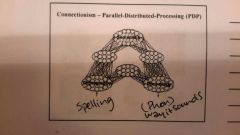
Parallel-Distrubuted-Processing Network that learns assoc. between input and outputs |
|
|
|
Similarities between PDP and network of neurons |
-both are interconnected networks -each unit receives input from many other units -each unit provides an output to many other units -Units either are on (they fire) or off (they don't) -Connections between units can be strengthened or weakened |
|
|
|
Differences between PDP and network of neurons |
-Network of neurons is large and complex PDP network is small and simple' -Neurons react differently to different neurotransmitters (PDP ignores) |
|
|
|
Central Nervous System |
brain and spinal cord |
|
|
|
Somatic Nervous System |
sense organs to CNS CNS to muscles |
|
|
|
Automatic Nervous System |
Sympathetic (prepares for rigorous activity - increase HR)
Parasympathetic (prepares for rest - decreases HR) |
|
|
|
Where is dorsal? superior? posterior? caudal? anterior? rostral? ventral? inferior? |
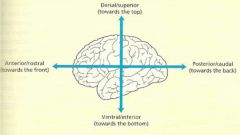
|
|
|
|
Where is Anterior? Posterior? Medial? Coronal? Sagittal? Horizontal? Axial? Anterior? Fosterior? |
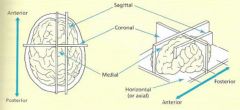
|
|
|

Which cut is what? |

|
|

